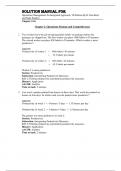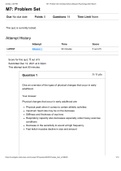Solution Manual For
Operations Management An Integrated Approach, 7th Edition By R. Dan Reid
and Nada Sanders
Chapter 2-16
Chapter 2: Operations Strategy and Competitiveness
1. Two workers have the job of placing plastic labels on packages before the
packages are shipped out. The first worker can place 1000 labels in 30 minutes.
The second worker can place 850 labels in 20 minutes. Which worker is more
productive?
Answer:
Productivity of worker 1 1000 labels / 30 minutes
33.3 labels per minute
Productivity of worker 2 850 labels / 20 minutes
42.5 labels per minute
Worker 2 is more productive.
Section: Productivity
Subsection: Interpreting Productivity Measures
LO: 2.5 Define productivity and identify productivity measures.
Bloom’s: Application
AACSB: Analytic
Time on task: 2 minutes
2. Last week a painter painted four houses in three days. This week she painted six
houses in four days. In which week was the painter more productive?
Answer:
Productivity in week 1 4 houses / 3 days 1.33 houses per day
Productivity in week 2 6 houses / 4 days 1.5 houses per day
The painter was more productive in week 2.
Section: Productivity
Subsection: Interpreting Productivity Measures
LO: 2.5 Define productivity and identify productivity measures.
Bloom’s: Application
AACSB: Analytic
Time on task: 2 minutes
,3. One type of bread-making machine can make six loaves of bread in five hours. A
new model of the machine can make four loaves in two hours. Which model is
more productive?
Answer:
Productivity of old model machine 6 loaves / 5 hours 1.2 loaves per hour
Productivity of new model machine 4 loaves / 2 hours 2.0 loaves per hour
The new model is more productive.
Section: Productivity
Subsection: Interpreting Productivity Measures
LO: 2.5 Define productivity and identify productivity measures.
Bloom’s: Application
AACSB: Analytic
Time on task: 2 minutes
4. A company that makes kitchen chairs wants to compare productivity at two of its
facilities. At facility #1, five workers produced 225 chairs. At facility #2, six
workers produced 263 chairs during the same time period. Which facility was
more productive?
Answer:
Productivity at facility #1 225 chairs / 5 workers 45 chairs per worker
Productivity at facility # 2 263 chairs / 6 workers 43.8 chairs per worker
Facility #1 was more productive.
Section: Productivity
Subsection: Interpreting Productivity Measures
LO: 2.5 Define productivity and identify productivity measures.
Bloom’s: Application
AACSB: Analytic
Time on task: 2 minutes
5. A painter is considering using a new high-tech paint roller. Yesterday he was able
to paint three walls in 45 minutes using his old method. Today he painted two
walls of the same size in 20 minutes. Is the painter more productive using the new
paint roller?
Answer:
Productivity using old method 3 walls / 45 minutes 0.07 walls per minute
Productivity using new method 2 walls / 20 minutes 0.10 walls per minute
The painter is more productive using the new paint roller.
Section: Productivity
Subsection: Interpreting Productivity Measures
LO: 2.5 Define productivity and identify productivity measures.
Bloom’s: Application
AACSB: Analytic
, Time on task: 2 minutes
6. Aztec Furnishings makes hand-crafted furniture for sale in its retail stores. The
furniture maker has recently installed a new assembly process, including a new
sander and polisher. With this new system, production has increased to 95 pieces
of furniture per day from the previous 55 pieces of furniture per day. The number
of defective items produced has dropped from 8 pieces per day to 2 per day. The
production facility operates strictly eight hours per day. Evaluate the change in
productivity for Aztec using the new assembly process.
Answer:
Using only the non-defective production, productivity has increased from (55 – 8)
= 47 pieces per day to (95 – 2) = 93 pieces per day.
Change in productivity = (93 – 47)/47 × 100% = 97.9%
There is a 97.9% increase in productivity using the new assembly process.
Section: Productivity
Subsection: Interpreting Productivity Measures
LO: 2.5 Define productivity and identify productivity measures.
Bloom’s: Application
AACSB: Analytic
Time on task: 3 minutes
7. Howard Plastics produces plastic containers for use in the food packaging
industry. Last year its average monthly production included 20,000 containers
produced using one shift five days a week with an eight-hour-a-day operation. Of
the items produced 15 percent were deemed defective. Recently, Howard Plastics
has implemented new production methods and a new quality improvement
program. Its monthly production has increased to 25,000 containers with 9 percent
defective.
a) Compute productivity ratios for the old and new production system.
b) Compare the changes in productivity between the two production systems.
Answer:
a) Using only the nondefective production, productivity increased from (20,000
× 0.85) = 17,000 units/month to (25,000 × 0.91) = 22,750 units/month.
b) Change in productivity = (22,750 – 17,000)/17,000 × 100% = 33.8%
There is a 33.8% increase in productivity using the new production method.
Section: Productivity
Subsection: Interpreting Productivity Measures
LO: 2.5 Define productivity and identify productivity measures.
Bloom’s: Application
AACSB: Analytic
Time on task: 4 minutes
8. Med-Tech labs is a facility that provides medical tests and evaluations for
patients, ranging from analyzing blood samples to performing magnetic resonance
imaging (MRI). Average price to patients is $85 per patient. Labor costs average
$18 per patient, materials costs are $22 per patient, and overhead costs are
averaged at $20 per patient.
a) What is the multifactor productivity ratio for Med-Tech? What does your
finding mean?
, b) If the average lab worker spends four hours for each patient, what is the labor
productivity ratio?
Answer:
a) Multifactor productivity = $85/($18 + $22 + $20) = 1.42
This means that the lab is charging approximately 42% over the expenses of labor,
materials, and overhead.
b) Labor productivity = $85/4 hours = $21.25 per hour
Section: Productivity
Subsection: Measuring Productivity
LO: 2.5 Define productivity and identify productivity measures.
Bloom’s: Application
AACSB: Analytic
Time on task: 4 minutes
9. Handy-Maid Cleaning Service operates five crews with three workers per crew.
Different crews clean a different number of homes per week and spend a differing
amount of hours. All the homes cleaned are about the same size. The manager of
Handy-Maid is trying to evaluate the productivity of each of the crews. The
following data have been collected over the past week.
Work Crew Hours Homes Cleaned
Anna, Sue, and Tim 35 10
Jim, Jose, and Andy 45 15
Dan, Wendy, and Carry 56 18
Rosie, Chandra, and Seth 30 10
Sherry, Vicky, and Roger 42 18
Assuming the quality of cleaning was consistent between crews, which crew was
most productive?
Answer:
Productivity of Anna, Sue, and Tim = 10 homes/35 hours = 0.29 homes/hour
Productivity of Jim, Jose, and Andy = 15 homes/45 hours = 0.33 homes/hour
Productivity of Dan, Wendy, and Carry = 18 homes/56 hours = 0.32 homes/hour
Productivity of Rosie, Chandra, and Seth = 10 homes/30 hours = 0.33 homes/hour
Productivity of Sherry, Vicky, and Roger = 18 homes/42 hours = 0.43 homes/hour
The crew of Sherry, Vicky, and Roger was the most productive.
Section: Productivity
Subsection: Interpreting Productivity Measures
LO: 2.5 Define productivity and identify productivity measures.
Bloom’s: Application
AACSB: Analytic
Time on task: 5 minutes





